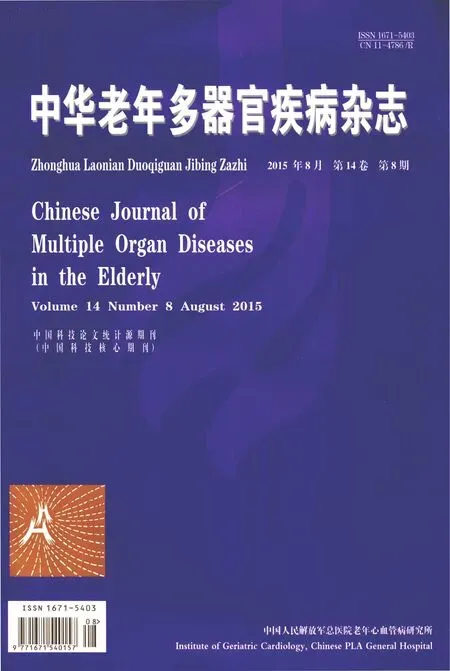老年痴呆患者代谢指标及炎症因子的临床分析
杨春华,徐雯霞,庞小芬
老年痴呆患者代谢指标及炎症因子的临床分析
杨春华,徐雯霞,庞小芬*
(上海交通大学附属瑞金医院卢湾分院老年科,上海 200025)
探讨阿尔茨海默病(AD)和血管性痴呆(VD)患者血浆中血糖、血脂、尿酸和炎症因子等代谢指标的临床意义。对2013年1月至2015年2月在上海交通大学附属瑞金医院卢湾分院老年科门诊和住院部患者采用简易智能状态量表(MMSE)进行痴呆筛选,分组测定AD组27例、VD组32例和对照组30例患者的体质量指数(BMI)、收缩压(SBP)、舒张压(DBP)、尿酸(UA)、空腹血糖(FPG)、糖化血红蛋白(HbA1c)、总胆固醇(TC)、甘油三酯(TG)、低密度脂蛋白胆固醇(LDL-C)、高密度脂蛋白胆固醇(HDL-C)、C−反应蛋白(CRP)、白细胞介素−6(IL-6)的水平。AD组和VD组与对照组比较,SBP、FPG、HbA1c有显著升高,且差异有统计学意义(<0.05)。UA水平低于对照组,但差异无统计学意义(>0.05);血浆TC、TG、LDL-C均明显升高(<0.05),HDL-C明显降低(<0.01),但AD组和VD组差异无统计学意义(>0.05)。CRP、IL-6水平较对照组明显升高(<0.05),且VD组较AD组升高更为明显(<0.05)。AD和VD老年患者中存在血糖、血脂,尿酸代谢异常和炎症反应。调节血糖、血脂可能是有效防治老年期痴呆的措施之一。
阿尔茨海默病;痴呆,血管性;血糖;血脂障碍;C−反应蛋白质;白细胞介素−6
随着社会人口的老龄化,老年痴呆患者的发病率也逐年增加,其防治已成为世界性社会问题之一。阿尔茨海默病(Alzheimer’s disease,AD)和血管性痴呆(vascular dementia,VD)是老年期痴呆中最常见的类型。有资料报道,AD占痴呆患者总数的50%~60%,VD占15%~20%[1]。近年来越来越多的国内外研究发现,高血压、高血糖、高脂血症、高尿酸血症、炎症因子等均成为AD与VD的危险因素。本研究旨在通过对上海交通大学附属瑞金医院卢湾分院2013年1月至2015年2月期间AD和VD患者的血压、血糖、血脂、尿酸(uric acid,UA)、炎症因子等代谢指标的情况进行对比研究分析,评价这些指标在早期诊断AD和VD中的作用,为临床早期干预提供依据。
1 对象与方法
1.1 研究对象
对2013年1月至2015年2月我院老年科门诊和住院部患者采用简易智能状态量表(Mini-Mental State Examination,MMSE)进行痴呆筛选,MMSE在相应教育程度分值以下为痴呆(文盲≤17分,小学文化≤20分,初中以上文化≤24分)。然后根据以下相关标准将受检者分为AD组和VD组。另外选取门诊及住院的无智力障碍的老年人为对照组。AD组27例,男11例,女16例,年龄(82.12±4.52)岁,均符合美国神经病学、交流障碍和卒中学会−老年性痴呆和相关疾病联合会(National Institute of Neurological and Communicative Disorders and Stroke and the Alzheimer’s Disease and Related Disorders Association,NINCDS-ADRDA)临床诊断标准。VD组32例,男15例,女16例,年龄(84.54±6.03)岁,均符合美国国立神经系统疾病与卒中研究所和瑞士国际神经科学研究联合会(NINDS/AIREN)中VD诊断标准。对照组30例,男14例,女16例,年龄(81.54±7.54)岁,与痴呆组相匹配。所有患者均无其他脑器质性疾病。
1.2 实验方法
所有研究对象均在空腹状态下测量身高、体质量、血压,计算体质量指数(body mass index,BMI)=体质量/(身高)2,静脉血检测血脂、肝肾功能、空腹血糖(fasting plasma glucose,FPG;贝克曼全身自动生化分析仪)、糖化血红蛋白(glycosylated hemoglobin A1c,HbA1c;色谱分析法,DSS分析仪测定)、C−反应蛋白(C-reactive protein,CRP),将剩余血清于-20℃冷藏保存,采用酶联免疫吸附法(enzyme linked immunosorbent assay,ELISA)统一测定白细胞介素−6(interleukin-6,IL-6)水平。
1.3 统计学处理

2 结 果
2.1 MMSE得分
对照组(27.25±1.12)分,得分正常,无认知功能损害;AD组(14.61±3.85)分,VD组(13.55±3.87)分,AD组和VD组两组患者认知功能均有明显损害(<0.01),但两者间差异无统计学意义(>0.05),符合纳入试验标准。
2.2 各组基本临床资料比较
与对照组比较,AD组和VD组的收缩压(systolic blood pressure,SBP)、FPG、HbA1c均有显著升高,且差异具有统计学意义(<0.01,<0.05)。血浆UA水平低于对照组,但差异无统计学意义(>0.05;表1)。

表1 各组基本临床资料比较
AD: Alzheimer’s disease; VD: vascular dementia; BMI: body mass index; SBP: systolic blood pressure; DBP: diastolic blood pressure; UA: uric acid; FPG: fasting plasma glucose; HbA1c: glycosylated hemoglobin Alc. 1mmHg=0.133kPa. Compared with control group,*<0.05,**<0.01
2.3 各组患者血脂和血浆炎症因子的测定
与对照组比较,AD组和VD组血浆总胆固醇(total cholesterol,TC)、甘油三酯(三酰甘油,triglycerides,TG)、低密度脂蛋白胆固醇(low-density lipoprotein cholesterol,LDL-C)均明显升高(<0.05),高密度脂蛋白胆固醇(high-density lipoprotein cholesterol,HDL-C)明显降低(<0.01);但AD组和VD组之间相比,差异无统计学意义(>0.05)。AD组和VD组血浆中CRP、IL-6水平明显较对照组升高(<0.05),且VD组较AD组升高更为明显(<0.05;表2)。
3 讨 论
随着社会进步和人均寿命的延长,高龄老年人群逐渐增多,痴呆在老年人中发病率越来越高,使患者生活质量下降,造成家庭和社会的沉重负担。如何预防和减缓痴呆的进展逐渐成为目前研究的热点。有研究提示AD早期与动脉粥样硬化可能具有相同的发生机制,内皮功能障碍、内皮损伤和动脉粥样硬化可能成为AD的血管性危险因素[2]。血清TC升高可导致脑动脉和毛细血管内皮细胞功能受损,加速动脉粥样硬化,降低脑血流量,使脑代谢受损,从而增加认知功能障碍和痴呆的危险性。此外,高TC血症可能通过β淀粉样蛋白(amyloid β-protein,Aβ)前体基因的处理过程,致使Aβ沉积,从而影响AD的发生、发展。另有研究结果表明HDL-C浓度与动脉粥样硬化发生的危险性呈负相关,HDL-C除具有逆转胆固醇作用外,同时具有抗氧化、抗血栓形成的作用[3]。LDL-C是血浆中主要带胆固醇的脂蛋白,在代谢过程中损伤血管内皮细胞,使管壁通透性增加,同时沉积大量的胆固醇酯,所以LDL-C浓度升高与HDL-C浓度降低被认为是动脉硬化的主要危险因素,加速了痴呆病程的发展。

表2 各组患者血脂和血浆炎症因子的测定
AD: Alzheimer’s disease; VD: vascular dementia; TC: total cholesterol; TG: triglycerides; LDL-C: low-density lipoprotein cholesterol; HDL-C: high-density lipoprotein cholesterol; CRP: C-reactive protein; IL-6: interleukin-6. Compared with control group,*<0.05,**<0.01; compared with AD group,#<0.05,##<0.01
目前关于AD与血中各脂类水平的关系仍未有肯定的结论,AD患者的血脂水平国内外研究结果尚不一致。本研究结果发现AD组和VD组TC、TG、LDL-C明显高于对照组(<0.05),HDL-C显著明显低于对照组(<0.01),但AD组和VD组之间差异无统计学意义(>0.05),证实了AD患者存在血脂代谢异常。本研究中AD组和VD组TC、TG、LDL-C水平的变化与国内原铁铮[4]的研究结果一致。而本研究中的HDL-C结果则与de Craen等[5]及柳华等[6]的研究结果一致。根据研究结果,我们建议可将HDL-C水平降低作为预测AD早期生化指标之一,并可进行有针对性的治疗干预。
近年研究认为,血液凝固因子和炎症因子参与了AD和VD的发病机制,血清中过高的血液凝固因子和炎症因子能导致血栓形成,加速动脉粥样硬化,促进AD和VD的发生。本研究结果表明CRP和IL-6参与了认知功能损害的发病,与相关研究结果一致[7,8]。在临床上对这类患者进行抗炎治疗,有望改善或延缓患者认知功能损害的进程。同时,本研究中VD患者血浆中CRP和IL-6水平比AD患者明显升高,表明炎症因子可能对血管的损害更为严重,加速了动脉粥样硬化,导致在VD患者中炎症反应更强烈。
2型糖尿病与VD的发病具有相关性,其与AD发病的相关性证据也在不断地增加。美国1991至1996年对1 262名老年人群调查显示,1/3的痴呆与糖尿病有关[9]。前瞻性研究也证实,老年2型糖尿病患者认知功能测试的得分低于非糖尿病者,并且在2~6年的随访过程中发现其认知功能的危险随时间增加,糖尿病可通过多种途径影响脑部血供和脑功能[10]。国内宋彦等[11]研究发现一定剂量的UA可有效改善AD大鼠的学习记忆能力,且UA对改善大鼠学习记忆能力存在量效关系,故对于改善AD认知功能、延缓病情进展、提高疗效具有重要的意义。UA具有抗氧化和促氧化双重性质,因此UA水平过高和过低都有可能影响认知功能,导致痴呆的发生,找到一个合适范围的UA浓度,还需要大量的工作。而本研究的结果,UA水平低于对照组,但差异无统计学意义(>0.05),可能与样本量不大有关,尚需足够大样本量来进行更深入的分层研究。
综上所述,本研究通过对痴呆患者的血糖、血脂、尿酸及炎症因子等代谢指标为切入点,观察AD及VD患者的各项指标水平变化。结果可见,AD和VD患者中存在血糖、血脂、UA及炎症因子等代谢异常,调节血脂、血糖有助于防治和延缓老年痴呆。
[1] Leifer BP. Early diagnosis of Alzheimer’s disease: clinical and economic benefits[J]. J Am Geriatr Soc, 2003, 51(5 Suppl Dementia): S281−S288.
[2] van der Flier WM, Scheltens P. Epidemiology and risk factors of dementia[J]. J Neurol Neurosurg Psychiatry, 2005, 76(Suppl 5): V2−V7.
[3] Liao JK. Statins and ischemic stroke[J]. Atheroscler Suppl, 2002, 3(1): 21−25.
[4] Yuan TZ. Changes in blood lipids and the level of CRP in patients with Alzheimer’s disease and vascular dementia[J]. Chin J Gerontol, 2011, 31(8): 1439−1440. [原铁铮. 阿尔茨海默病与血管性痴呆患者血脂及CRP水平变化[J]. 中国老年学杂志, 2011, 31(8): 1439−1440.]
[5] de Craen AJ, Gussekloo J, Teng YK,. Prevalence of five common clinical abnormalities in very elderly people: population based cross-sectional study[J]. BMJ, 2003, 327(7407): 131−132.
[6] Liu H, Chang LH. The relationship between high density lipoprotein and cognitive impairment in elderly patients[J]. J Jinggangshan Med Coll, 2003, 10(3): 74. [柳 华, 常履华. 年耄老人高密度脂蛋白(HDL)与认知损害的关系[J]. 井冈山医专学报, 2003, 10(3): 74.]
[7] Wada-Isoe K, Wakutani Y, Urakami K,. Elevated interleukin-6 levels in cerebrospinal fluid of vascular dementia patients[J]. Acta Neurol Scand, 2004, 110(2): 124−127.
[8] Zuliani G, Guerra G, Ranzini M,. High interleukin-6 plasma levels are associated with functional impairment in older patients with vascular dementia[J]. Int J Geriatr Psychiatry, 2007, 22(4): 305−311.
[9] Luchsinger JA, Tang MX, Stern Y. Diabetes mellitus and risk of Alzheimer’s disease and dementia with stroke in a multiethnic cohort[J]. Am J Epidemiol, 2001, 154(7): 635−641.
[10] Logroscino G, Kang JH, Grodstein F. Prospective study of type 2 diabetes and cognitive decline in women aged 70−81 years[J]. BMJ, 2004, 328(7439): 548.
[11] Song Y, Suo AQ, Ding XM,. The effects and mechanism of uric acid on learning-memory ability in the rat model of Alzheimer’s disease[J]. Chin J Nerv Ment Dis, 2011, 37(10): 603−606. [宋 彦, 索爱琴, 丁旭萌, 等. 尿酸对阿尔茨海默病大鼠学习记忆能力的影响及其机制[J]. 中国神经精神疾病杂志, 2011, 37(10): 603−606.]
(编辑: 李菁竹)
Clinical analysis of metabolic indices and inflammatory factors in patients with senile dementia
YANG Chun-Hua, XU Wen-Xia, PANG Xiao-Fen*
(Department of Geriatrics, Luwan Branch of Ruijin Hospital, Shanghai Jiao Tong University, Shanghai 200025, China)
To investigate the clinical significances of blood glucose, blood lipids, uric acid (UA) and inflammatory factors between the patients with Alzheimer’s disease (AD) and vascular dementia (VD).Mini-Mental State Examination (MMSE) was used to survey the elderly in-patients and out-patients in the Luwan Branch of Ruijin Hospital from January 2013 to February 2015. Finally, 27 AD patients, 32 VD patients and 30 sex- and age-matched normal individuals were enrolled in this study. Their body mass index (BMI), systolic blood pressure (SBP), diastolic blood pressure (DBP), UA, fasting plasma glucose (FPG), glycosylated hemoglobin (HbA1c), total cholesterol (TC), triglycerides (TG), low-density lipoprotein cholesterol (LDL-C), high-density lipoprotein cholesterol (HDL-C), C-reactive protein (CRP) and interleukin-6 (IL-6) were measured.The SBP, FPG and HbA1c were markedly higher in the AD and VD patients than in the normal controls (<0.05). The UA level was lower in AD and VD patients than in controls, but there was no significant difference. The AD and VD patients had significantly higher TC, TG and LDL-C levels (<0.05) and obviously lower HDL-C level (<0.01) than the normal individuals, but there was no significant difference between the AD and VD patients (>0.05). Compared with normal controls, both AD and VD patients had markedly higher CRP and IL-6 levels (<0.05), and more obvious in the latter group (<0.05).The elderly patients with AD and VD have abnormal metabolism of glucose and lipids and inflammatory reaction. Regulation of blood lipids and glucose may be one of the effective measures in the prevention and treatment of SD.
Alzheimer’s disease; dementia, vascular; blood glucose; dyslipidemias; C-reactive protein; interleukin-6
R592; R749.16
A
10.11915/j.issn.1671-5403.2015.08.140
2015−03−28;
2015−04−27
庞小芬, E-mail: XiaoFenPang@126.com

